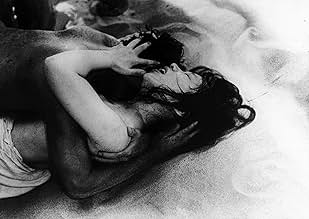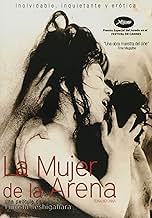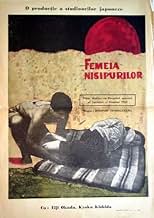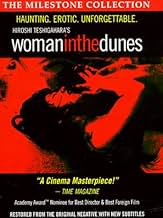Ein Entomologe auf Urlaub wird von Dorfbewohnern dazu getrieben, mit einer Frau zusammenzuleben, deren Lebensaufgabe darin besteht, für sie Sand zu schaufeln.Ein Entomologe auf Urlaub wird von Dorfbewohnern dazu getrieben, mit einer Frau zusammenzuleben, deren Lebensaufgabe darin besteht, für sie Sand zu schaufeln.Ein Entomologe auf Urlaub wird von Dorfbewohnern dazu getrieben, mit einer Frau zusammenzuleben, deren Lebensaufgabe darin besteht, für sie Sand zu schaufeln.
- Für 2 Oscars nominiert
- 11 Gewinne & 3 Nominierungen insgesamt
Empfohlene Bewertungen
A man who is searching for a unique insect in a sandy dessert area ends up trapped in a sandpit where a young woman lives. It becomes apparant that while the man can not escape the woman decides this is her future and that there is little she can do but accept it.
The film is an old black and white film, and many a times it is hard to see what is going on. The story is slow paced, and there is a lot of confusion through much of the film as to why the characters are in this 'unusual' situation. However, I completely got into it and was absorbed by the man who was felt trapped like an animal, and the woman who was accepting of her fate and somewhat comfortable. Also the shots of the dunes are spectacular, the film feels totaly claustrophobic, and it's one of this films which you keep asking yourself every 5 minutes, "How the heck did the film this!?".
But because of its slow nature and somewhat snail pacing and payoff many might not like it. Too bad.
Rating 8 out of 10.
I watched this movie on a Japanese Film Festival in Berlin in 1993. I can't remember all the details but the movie really mesmerized me. It is a very unique work and I wonder why it doesn't have the cult status of other movies.
The psychology between the two is excellently depicted. The tension is intensified trough images of sweaty skin and running sand. The cinematographer is a master in filming this. Lots of black. Editing also is sharp and very well done. Sound is minimal and fits the images' bleak and deserted dunes.
Much can be said about this movie, it is one for repeated viewings for sure.
The film reflects existential, not Zen, themes, and belongs with Camus and Beckett. Life is meaningless in this pit, there is no escape, and the day to day toil is not only a struggle, but absurd and nonsensical. There is clearly a parallel being drawn to the bugs being buried in the sand as well as struggling futilely in test tubes earlier in the movie. It also reflects man's cruelty in the bugs pinned on boards to the forced labor. The scene towards the end, where the villagers look impassively down through masks and glasses with the taiko drums pounding, demanding a lewd display, is chilling.
There are a couple of very raw erotic scenes between Okada and Kishida, heightened by the conditions they find themselves in, and notably occurring as one wipes the other down. In trying to free ourselves of this painful world and the grime it coats us with, if even for only moments, we turn to the embrace of another, and take comfort in carnal moments. It's beautiful and somewhat pathetic at the same time. Okada also experiences a moment of transcendence when he invents a water pump, and sees it as a higher achievement than his original goal of discovering a new species of beetle and having it named after him. There is humanity again, displaying intelligence in improving his lot, and vanity. It's a somewhat grim film, but there is solace in these things. Definitely worth watching.
Wusstest du schon
- WissenswertesFor this film, Hiroshi Teshigahara became the first Japanese director to be nominated for an Oscar for directing.
- PatzerThe beard of teacher Jumpei is not growing, despite him even complaining about no opportunity to shorten it.
- Zitate
Entomologist Niki Jumpei: The certificates we use to make certain of one another: contracts, licenses, ID cards, permits, deeds, certifications, registrations, carry permits, union cards, testimonials, bills, IOUs, temporary permits, letters of consent, income statements, certificates of custody, even proof of pedigree. Is that all of them? Have I forgotten any? Men and women are slaves to their fear of being cheated. In turn they dream up new certificates to prove their innocence. No one can say where it will end. They seem endless.
- VerbindungenFeatured in Music for the Movies: Tôru Takemitsu (1994)
Top-Auswahl
- How long is Woman in the Dunes?Powered by Alexa
Details
- Laufzeit2 Stunden 27 Minuten
- Farbe
- Seitenverhältnis
- 1.37 : 1
Zu dieser Seite beitragen



























